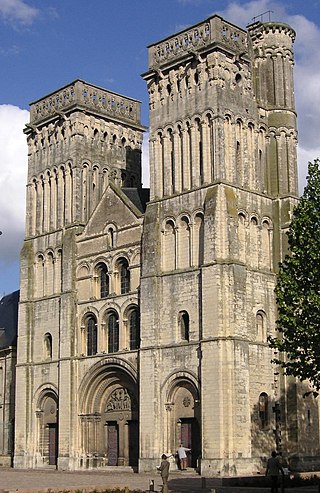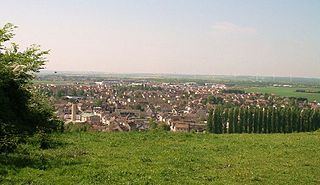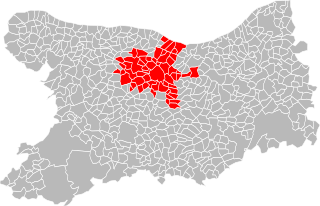
Caen is a commune 15 km (9.3 mi) inland from the northwestern coast of France. It is the prefecture of the department of Calvados. The city proper has 105,512 inhabitants, while its functional urban area has 470,000, making Caen the second largest urban area in Normandy and the 19th largest in France. It is also the third largest commune in all of Normandy after Le Havre and Rouen.

Lower Normandy is a former administrative region of France. On 1 January 2016, Lower and Upper Normandy merged becoming one region called Normandy.

Lutetia, also known as Lutecia and Lutetia Parisiorum, was a Gallo–Roman town and the predecessor of modern-day Paris. Traces of an earlier Neolithic settlement have been found nearby, and a larger settlement was established around the middle of the third century BC by the Parisii, a Gallic tribe. The site was an important crossing point of the Seine, the intersection of land and water trade routes.

Argences is a commune in the Calvados department in the Normandy region of north-western France. It is in the urban area of Caen, 15 kilometres from the city.

Saint-Lô is a commune in northwest France, the capital of the Manche department in the region of Normandy.

The Tour Saint-Jacques is a monument located in the 4th arrondissement of Paris, France, at the intersection of Rue de Rivoli with Rue Nicolas Flamel. This 52-metre (171 ft) Flamboyant Gothic tower is all that remains of the former 16th-century Church of Saint-Jacques-de-la-Boucherie, which was demolished in 1797, during the French Revolution, leaving only the tower.

Argentoratum or Argentorate was the ancient name of the city of Strasbourg. The name was first mentioned in 12 BC, when it was a Roman military outpost established by Nero Claudius Drusus. From 90 AD the Legio VIII Augusta was permanently stationed there.

Arnay-le-Duc is a commune in the Côte-d'Or department in the Bourgogne-Franche-Comté region of eastern France.

Altorf is a commune in the Bas-Rhin department in the Grand Est region of northeastern France.

Bavay is a commune in the Nord department in the Hauts-de-France region of northern France. The town was the seat of the former canton of Bavay.

The communauté urbaine Caen la Mer is the communauté urbaine, an intercommunal structure, centred on the city of Caen. It is located in the Calvados department, in the Normandy region, northwestern France. It was created in January 2017, replacing the previous Communauté d'agglomération Caen la Mer and two communautés de communes. Its area is 362.9 km2. Its population was 268,470 in 2018, of which 105,512 in Caen proper.

The Abbey of Saint-Étienne, also known as Abbaye aux Hommes by contrast with the Abbaye aux Dames, is a former Benedictine monastery in the French city of Caen, Normandy, dedicated to Saint Stephen. It was founded in 1063 by William the Conqueror and is one of the most important Romanesque buildings in Normandy.

The Church of Saint-Pierre is a Roman Catholic church located on the Place Saint-Pierre in the centre of Caen in Normandy, northern France. It is dedicated to Saint Peter.

The Château de Caen is a castle in the Norman city of Caen in the Calvados département (Normandy). It has been officially classed as a Monument historique since 1997.

Trophime Bigot (1579–1650), also known as Théophile Bigot, Teofili Trufemondi, the Candlelight Master, was a French painter of the Baroque era, active in Rome and his native Provence.

Cerisy Abbey, otherwise the Abbey of Saint Vigor, located in Cerisy-la-Forêt, Manche, France, was an important Benedictine monastery of Normandy.

Troarn Abbey or Abbey Saint-Martin de Troarn was a Benedictine abbey in the French town of Troarn, now in the Calvados department of Lower Normandy. It was dedicated to Martin of Tours and founded by Roger I of Montgomery using twelve monks from Fécamp Abbey in 1022, as a satellite of that house. Around 1050 Roger II of Montgommery replaced this establishment with an independent Benedictine monastery. Its first church was dedicated in 1059. Roger II granted the monastery lands around Troarn, including the marshes and a series of parish churches, whilst his wife Mabille of Bellême granted it all the parish churches in Séez and William I of England added everything he had granted Mabille in England.

Saint-Gabriel-Brécy Priory was a Benedictine priory 10 km from the coast between Caen and Bayeux. It is sited in the town of Saint-Gabriel-Brécy, Calvados, France. A 13th century gate-tower survives, with ogive vaulting on sculpted capitals. It was adjoined by a now-lost guesthouse. The cornice is sculpted with small three-point arches. The vaulted refectory dates to the late 13th century. A keep was built to serve as a prison in the 15th century, whilst the Renaissance-style courtroom was built towards the end of the 16th century. A dovecote is now lost.

Regnobert of Bayeux, Regnobertus in Latin, also transcribed in Renobert, Rénobert, Rennobert or Raimbert, was the twelfth bishop of Bayeux and a Saint of the Roman Catholic Church in the 7th century.

The Church of Old Saint-Sauveur is a former place of worship on the Place Saint-Sauveur in the old town center of Caen, France. Before the French Revolution, the church was a parish and was called just Saint-Sauveur Church. It took its current name in 1802 when the Notre-Dame-de-Froide-Rue church, which became the center of the new parish, was renamed Saint-Sauveur Church in Caen. The church has been classified as a historical monument since 29 June 1951.





















